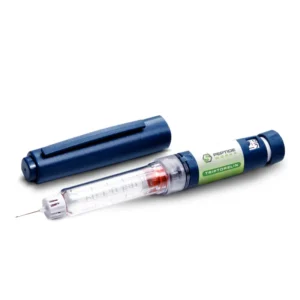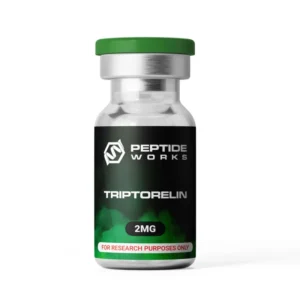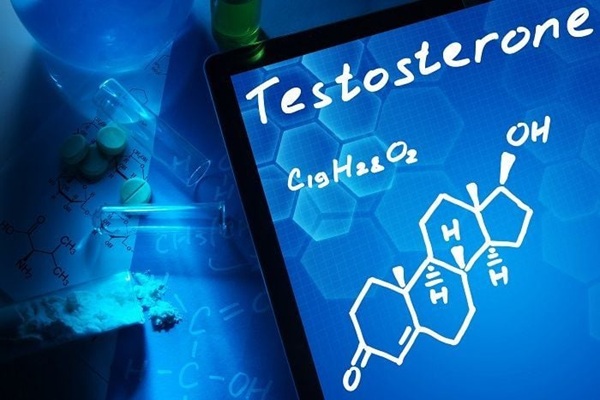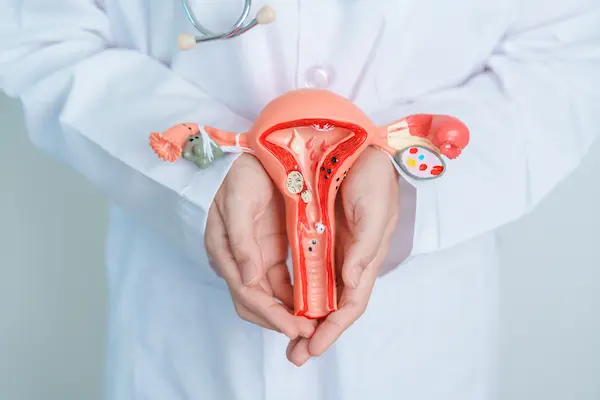PROMO!
First order? Get 10% OFF with this code: 1storder
Our Product Categories



Triptorelin is a synthetic version of a natural hormone made up of ten amino acids. The decapeptide works as a gonadotropin-releasing hormone (GnRH) agonist. When it’s first introduced into the body, it stimulates the release of certain hormones like luteinizing hormone (LH) and follicle-stimulating hormone (FSH). However, after the initial boost, it actually suppresses the production of these hormones, which leads to a decrease in the production of sex hormones.
Clinically, it is used to treat hormone-sensitive conditions like prostate cancer, endometriosis, precocious puberty, and uterine fibroids. It also aids in assisted reproductive technology (ART) and gender-affirming hormone therapy. Triptorelin is typically given by injection and effectively regulates hormone levels. However, long-term use can cause side effects like hot flashes, fatigue, and bone density loss. Its stability and potency make it a valuable tool in hormone-related treatments.
Peptide Sequence (IUPAC Condensed): H-Pyr-His-Trp-Ser-Tyr-D-Trp-Leu-Arg-Pro-Gly-NH2
Molecular Formula: C64H82N18O13
Molecular Weight: 1311.4 g/mol
Synonyms: LHRH, Tryptophyl(6)-, Triptorelin acetate

Triptorelin mimics a natural hormone called GnRH. At first, this causes the pituitary gland to release more LH and FSH. This leads to a temporary increase in sex hormones, for example, testosterone in men and estrogen in women. However, if Triptorelin is used continuously, it makes the pituitary gland’s GnRH receptors less responsive. This leads to a significant drop in LH and FSH levels, which in turn lowers the production of sex hormones by the gonads.
When Triptorelin is given continuously, it desensitizes GnRH receptors in the pituitary gland. This greatly reduces the release of LH and FSH. As a result, sex hormone production by the gonads is effectively lowered. This mechanism makes Triptorelin useful for treating hormone-sensitive conditions like prostate cancer, endometriosis, and precocious puberty, as well as for controlling hormone levels in fertility treatments.
Advanced Prostate Cancer:Research has shown that Triptorelin is highly effective in managing advanced prostate cancer (PC), which suppresses testosterone levels, a key driver of androgen-dependent tumors. In a pooled analysis of 920 patients, triptorelin sustained-release (SR) formulations reduced testosterone levels to <20 ng/dl in 79-93% of patients over 12 months, surpassing traditional thresholds [1].
Additionally, a meta-analysis demonstrated that the peptide significantly improved lower urinary tract symptoms (LUTS) and quality of life (QoL) in prostate cancer patients, with notable reductions in IPSS scores over 48 weeks. These findings highlight triptorelin’s dual benefits in tumor control and symptom management, improving patient outcomes [2].
Endometriosis and Uterine Fibroids: Research suggests that Triptorelin is effective in managing endometriosis and uterine fibroids. A phase 3 study in Chinese women with endometriosis showed that both 3-month and 1-month triptorelin formulations effectively reduced estradiol levels to castration levels (>98% success) and alleviated pelvic pain, with the 3-month option offering fewer injections and reduced care burden [3].
For uterine fibroids, studies have shown that preoperative triptorelin treatment significantly reduces myoma volume and improves surgical outcomes, including shorter hysteroscopy times and reduced fluid absorption. These findings highlight triptorelin’s role in reducing symptoms and improving surgical efficiency in patients with endometriosis and uterine fibroids [4].
Central Precocious Puberty (CPP): Research indicates that Triptorelin is highly effective in managing Central Precocious Puberty (CPP) in children. A study on the 3-month prolonged-release (PR) formulation showed 93.5–100% of children achieved luteinizing hormone (LH) suppression to prepubertal levels over 12 months, with stable sex hormone levels and reduced growth velocity. Bone age progression slowed, and physical development stabilized [5].
Another study combining triptorelin with cluster nursing demonstrated improved predicted adult height, reduced behavioral issues, and enhanced quality of life compared to standard care. Triptorelin was well-tolerated, with fewer adverse reactions, making it a safe and effective option for treating CPP in children [6].
Assisted Reproductive Technologies (ART): Research suggests that Triptorelin plays a significant role in improving outcomes in Assisted Reproductive Technologies (ART). Studies show that adding triptorelin during the luteal phase enhances pregnancy, ongoing pregnancy, and implantation rates, particularly in long agonist protocols [7].
Low-dose triptorelin is also effective for final oocyte maturation, achieving comparable results to standard doses without increasing ovarian hyperstimulation syndrome (OHSS) risk [8].
Additionally, innovative delivery methods like triptorelin-loaded microneedles improve bioavailability and reduce the need for frequent injections, easing the physical and psychological burden on women undergoing ART [9]. These findings highlight triptorelin’s efficacy and potential to enhance patient experience in ART treatments.
[1] J Breul, E Lundström, D Purcea, et al (2017) Efficacy of Testosterone Suppression with Sustained-Release Triptorelin in Advanced Prostate Cancer – Advances in Therapy, 2017 Feb, Volume 34 (Issue 2), Pages 513-523.
[2] R Barrett and B Birch (2023) Triptorelin therapy for lower urinary tract symptoms (LUTS) in prostate cancer patients: A systematic meta-analysis – BJUI Compass, 2023 Oct 10, Volume 5 (Issue 1), Pages 17-28.
[3] X Li, H Li, H Shi, et al (2022) Assessment of Two Formulations of Triptorelin in Chinese Patients with Endometriosis: A Phase 3, Randomized Controlled Trial – Adv Ther, 2022 Aug 10, Volume 39 (Issue 10), Pages 4663–4677.
[4] N Bizzarri, V Ghirardi, V Remorgida, et al (2015) Three-month treatment with triptorelin, letrozole and ulipristal acetate before hysteroscopic resection of uterine myomas: prospective comparative pilot study – European Journal of Obstetrics, Gynecology and Reproductive Biology, 2015 Sep, Volume 192, Pages 22-6.
[5] X Luo, C Zhang, Y Yang, et al (2023) Efficacy and Safety of Triptorelin 3-Month Formulation in Chinese Children with Central Precocious Puberty: A Phase 3, Open-Label, Single-Arm Study – Advances in Therapy, 2023 Oct, Volume 40 (Issue 10), Pages 4574-4588.
[6] H Wang and J Chen (2025) Clinical efficacy and influence on the quality of life of children with precocious puberty treated by combination of cluster nursing and triptorelin – Medicine (Baltimore), 2025 Sep 19, Volume 104 (Issue 38), Pag e44261.
[7] F.M. Fusia, M. Arnoldia, C. Bosisio, et al (2013) Triptorelin administration in the luteal phase improves the outcome of art cycles – Fertility and Sterility, Volume 100, Issue 3, S478.
[8] B Gülekli, F Göde, Z Sertkaya, ET AL (2015) Gonadotropin-releasing hormone agonist triggering is effective, even at a low dose, for final oocyte maturation in ART cycles: Case series – Journal of the Turkish-German Gynecological Association, 2015 Mar 1, Volume 16 (Issue 1), Pages 35–40.
[9] X Lu, Y Sun, M Han, et al (2023) Triptorelin nanoparticle-loaded microneedles for use in assisted reproductive technology – Drug Delivery, 2023 Jun 30, Volume 30 (Issue 1), Page 2226367.
The answers to the most frequently asked questions about Triptorelin.

Triptorelin is used in laboratory studies to explore how hormones affect growth, reproduction, and certain diseases. It helps scientists understand hormone control in conditions like early puberty, prostate cancer, and breast cancer. By reducing hormone signals, Triptorelin allows researchers to study how changes in hormone activity influence different biological systems and health outcomes.
Triptorelin lowers hormone levels that support the growth of some breast cancers. It acts on the brain’s signaling system to reduce ovarian estrogen production. With less estrogen available, hormone-sensitive cancer cells receive fewer growth signals. Researchers use Triptorelin to study hormone suppression and its effects on tumor biology, treatment modeling, and endocrine system control.
Triptorelin may cause short-term effects as hormone levels change. Common reactions include mild headaches, mood swings, hot flashes, or slight irritation at the injection site. These effects appear early as hormone signals drop and the endocrine system adjusts. Researchers note these changes to study hormone feedback control and its role in regulating growth and reproductive pathways.
In the United States, the FDA lists Triptorelin as a prescription-only drug when used for medical treatment. It cannot be supplied or administered to humans or animals without a valid prescription. Triptorelin produced for laboratory research is not FDA-approved for therapy but can be obtained legally by qualified researchers and institutions for non-human studies. Regulations may vary by region, so always check local laws before purchase.

This blog explains how Triptorelin works as a testosterone-lowering peptide. It describes its action on hormone regulation, the short-term testosterone flare that can occur, and its overall role in balancing hormones. The post also compares Triptorelin with Kisspeptin and Gonadorelin, which raise testosterone, showing how their different pathways help researchers study hormone function.

This blog explores Triptorelin’s potential as a peptide therapy for endometriosis. It explains how this GnRH agonist helps balance hormones, lower estrogen and ease symptoms such as pain and heavy bleeding. From the short-term flare effect to long-term hormone control, the post highlights its importance in endometriosis research and future treatment options.

This blog looks at the best peptides for women in perimenopause and how they may help with common issues like low libido, tiredness, mood changes, and skin health. It reviews research on peptides such as Kisspeptin, PT-141, and GHK-Cu, sharing insights into how they could support energy, recovery, and overall well-being during midlife.
ALL CONTENT AND PRODUCT INFORMATION AVAILABLE ON THIS WEBSITE IS FOR EDUCATIONAL PURPOSES ONLY.
DISCLAIMER: These products are intended solely as a research chemical only. This classification allows for their use only for research development and laboratory studies. The information available on our Peptide Works website: https://peptide-works.com/ is provided for educational purposes only. These products are not for human or animal use or consumption in any manner. Handling of these products should be limited to suitably qualified professionals. They are not to be classified as a drug, food, cosmetic, or medicinal product and must not be mislabelled or used as such.